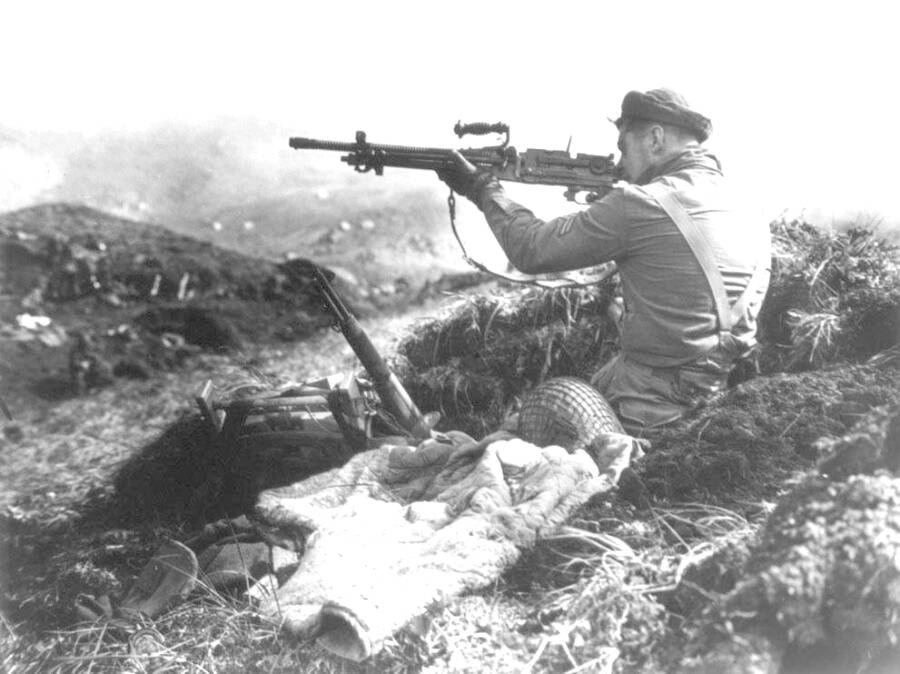By Ferdy Belland
When one talks of Canada’s involvement in World War II, thoughts usually turn to the better-known battles: the Fall of Hong Kong, the Dieppe Raid, the Invasion of Sicily, the Battle of Ortona, the D-Day assault on Juno Beach, or the Liberation of Holland. But too little historical spotlight is aimed on the battles Canadians fought in their own backyards, in their own waters, and sometimes even on their own soil.
World War II in the Pacific Theatre had already been blasting away at full steam and full throttle since July, 1937, when Japanese Imperial ambitions (which had annexed and absorbed the Chinese province of Manchuria into the Empire as the new puppet state of Manchukuo) broke into outright open undeclared warfare against the Republic of China.
The Japanese War in China was a brutal event. And for the next four years the Imperial Japanese Army used China as little more than the world’s largest military training ground for the larger war yet to come.
This larger war was smashed hard into the faces of the Western powers on the morning of 7 December, 1941, with the vicious sneak attack on the massive US Navy base at Pearl Harbor in the Hawaiian Islands, where the American Pacific Fleet was anchored. The Americans, the British, the Dutch — all had underestimated the Japanese as a weak, inferior nation, and that offhanded racist dismissal now lead to six solid months of military disaster for the Allies. The British imperial enclaves of Hong Kong and Singapore, boasted as impregnable fortresses, fell in short order, and the Royal Navy presence in the Pacific ambushed and sunk shortly after that. The sizeable American garrison in the Philippines found itself outclassed, besieged, defeated, and death-marched off into captivity. Malaysia and Burma were overwhelmed by jungle-savvy Japanese troops — many of whom pedaled into battle on bicycles. The Dutch East Indies quickly folded. The citizenry of Australia and New Zealand tensely awaited the inevitable invasion fleets. Within the first four months following Pearl Harbor, the Allied military presence in the Pacific had either been neutralized or driven back thousands of kilometres.
And now with the so-called Greater East Asian Co-Prosperity Sphere established to the satisfaction of Emperor Hirohito and the Japanese War Cabinet, the sights were now aimed at other likely targets — namely, North America.
The Aleutian Islands are a long chain of 69 islands (as part of the “Ring of Fire,” many of them are dormant and not-so-dormant volcanos jutting up from the sea) that stretch nearly 1,900 km in a gradual northwards arc across the uppermost reaches of the North Pacific Ocean, reaching from Alaska all the way to the huge Russian peninsula of Kamchatka and forming the bottom border of the Bering Sea.
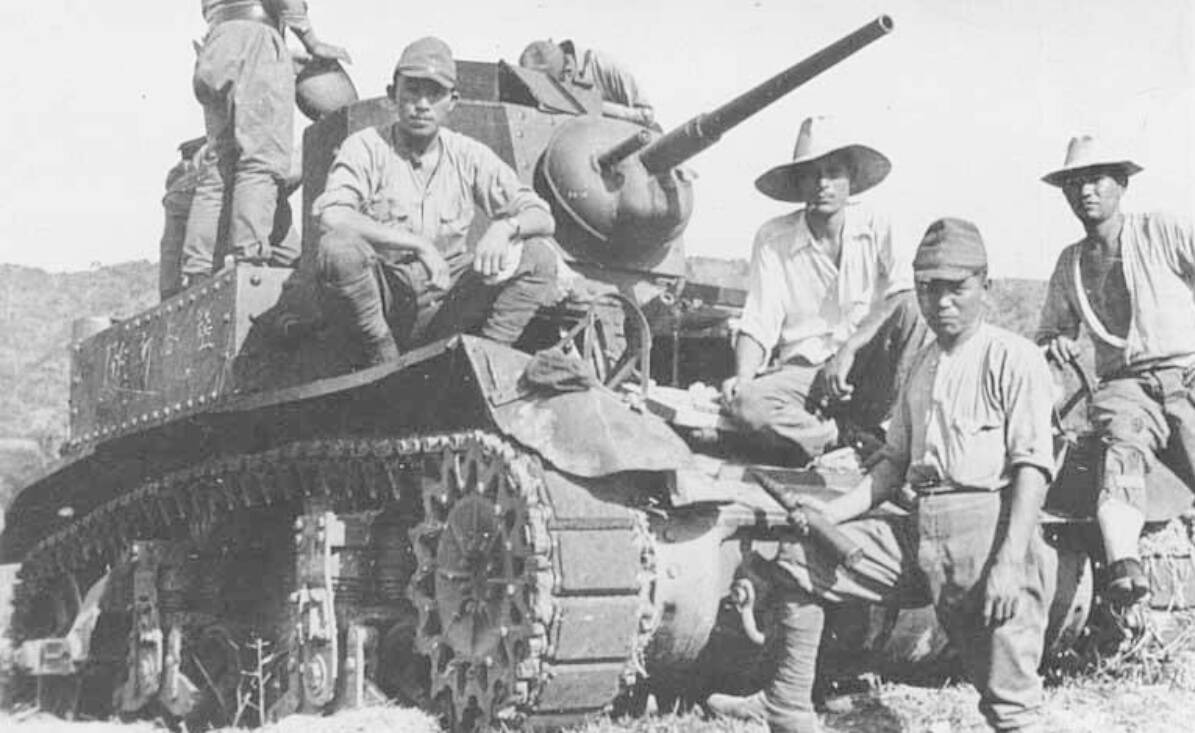
Pictured: Japanese troops on Kiska pose with their tank.
The Aleutians possess what many meteorologists deem the World’s Worst Weather — perpetually shrouded in thick fog with almost zero visibility; barren, rocky, icebound, wracked by howling Arctic winds; surrounded by some of the choppiest seas around (not very “pacific,” really); blanketed in heavy rains and deep snow at least 250 days of the year.
The strategic value placed on the Aleutians by the Japanese High Command was large. They were an easy target of opportunity, being of reasonable sailing distance from the Japanese Home Islands for an invasion fleet. They were sparsely populated (then as now) by only a few thousand people, most of them native Aleut fishermen, and existing US defenses were few and far between.
The Aleutians’ conquest would be the first incorporated US territory to be captured by the Axis Powers, which would deal another blow to American morale and fighting spirit. As early as 1935, US Army General Billy Mitchell (the father of the US Air Force) declared: “I believe that in the future, whoever holds Alaska will hold the world. I believe it is the most strategically important place in the world.” The Japanese agreed.
Japanese control of the Aleutians, with the establishment of strongly-equipped naval and air bases, would make the Americans hesitant to launch counterattacks across the Pacific, for fear of being struck across their flanks. Then the Aleutians would become a vital Axis staging area for attacks against Allied shipping, as well as a springboard for aerial attack against — and, eventually, massive invasions of Allied home territories: Alaska, Vancouver Island, the vital port cities of Vancouver, Seattle, and Portland, even targets as far south as California. The American and Canadian governments believed the danger as very real, and only a matter of time; they must fortify the Aleutians before the Japanese did.
But the Allies were going to lose the race.
On the orders of Grand-Admiral Isoroku Yamamoto (the mastermind behind the Pearl Harbor attack), a formidable Japanese invasion fleet (two aircraft carriers, five battle-cruisers, 12 destroyers, four troop transports, and six escort submarines) under the command of Vice-Admiral Boshiro Hosogaya burst out of the dense fog surrounding the Aleutian Islands without warning on 6 June 1942.
Devastating airstrikes launched against the vital US air base at Dutch Harbor spoiled any chance of immediate Allied interdiction, and so 8,500 Japanese troops splashed ashore on the larger Aleutian islands of Attu and Kiska. It had taken the shaken and shattered American war machine six months after Pearl Harbor to recover enough to push back against the Japanese onslaught in any strength, and with the crucial battle of Midway already underway far to the southwest, the bulk of available American naval forces in the Pacific was already committed. The Japanese attack on the Aleutians may not have caught the Allies completely by surprise, but significant response would not be great, or fast in coming.
And as for Canada? Canadian forces had been fully mobilized since the opening of European hostilities in September 1939, but by 1942 most of the Canadian Expeditionary Force was either stationed in England, training and preparing for the cross-Channel raid against the Nazi-occupied French port of Dieppe, or earmarked for the future invasions of Sicily and Italy once the North African Campaign was wrapped up. Most of the then-powerful Canadian Navy was already committed to Allied convoy duty in the Atlantic, and Canadian naval presence in the Pacific was symbolic at best (Coast Guard flotillas, etc.). The humiliation of the fall of Hong Kong on Christmas Day 1941 (where 290 Canadians were killed and another 783 marched off into miserable Japanese captivity) was still a raw wound, politically and militarily, and retaliation of any sort against the Japanese was hotly desired by both the Canadian leadership and the general public alike. And enemy bases suddenly appearing in Canada’s northern backyard could not be ignored.
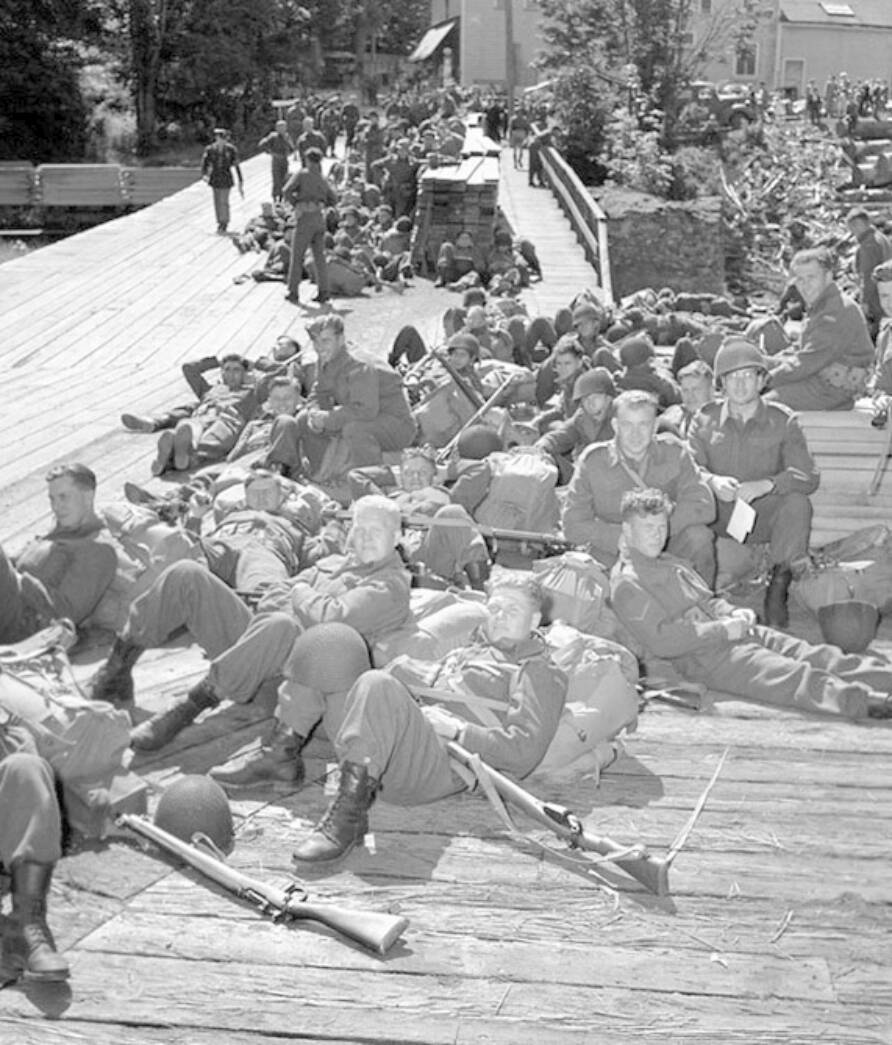
Pictured: Canadian troops arrive on Kiska Island, 21 July 1943
Two significant decisions were made by the Canadian government of then-Prime Minister William Lyon Mackenzie King to combat the new Arctic threat: the creation of the 1st Special Service Force, and the creation of the Alaska Highway.
The 1st Special Service Force (1SSF) was an elite commando unit of combined Canadian and American troops, under overall command of the US 5th Army. The 1SSF developed from the irregular-warfare concepts of both the Office of Strategic Services (OSS, the wartime precursor to the modern CIA) and MI-5 (British Military Intelligence), and following the Aleutian attacks the idea grew from small six-man raiding squads into a 1,400-man unit of brigade strength — ideas which would later sow the seeds for the Americans to form the Green Berets.
Recruits for the 1SSF from both sides of the 49th Parallel were drawn from desirable volunteers — single men aged 21-35 who had strong skills in the bush: lumberjacks, game wardens, hunting guides, explorers, prospectors, backwoodsmen, homesteaders — men who wouldn’t whimper or whine when shoved into the rocky ice-locked inhospitality of the Aleutian Islands.
A dedicated base for the 1SSF was established near Helena, Montana —built and maintained under the strictest military secrecy. Incoming troop transport trains had their windows blacked out and the baffled recruits were not told where they were going. Training was grueling and intense; up to 18 hours a day learning guerilla warfare, hand-to-hand combat, night fighting, marksmanship, parachuting, ambush, rafting assault, explosives and demolition, extended wilderness survival, small-unit tactics, large-unit tactics, and basically anything else deemed necessary to toughen up the common infantryman into a Super-Soldier.
Once the 1SSF’s commanders found the basic training completed to their satisfaction, the weary unit was then shipped off to other clandestine base-camps in remote areas of Virginia and Vermont for even harsher advanced training. By the end of June 1943 the 1st Special Service Force (now nicknamed “the Devil’s Brigade”) was considered combat-ready; now regarded as one of the toughest units in either the American or the Canadian armed services, the 1SSF then found themselves aboard troopships in San Francisco. On 10 July 1943 they were dispatched to the North Pacific to join in on the liberation of the Aleutian Islands — which were already underway.
* * *
As the 1SSF troopships approached the Aleutian Islands, the tense soldiers aboard were keeping up with ongoing reports of the battles in progress — battles they were soon to join. The Americans landed a strike force of 15,000 troops on the enemy-occupied island of Attu on 11 May (codenamed “Operation Landcrab”) and spent the next 18 days clearing the determined Japanese from their well-established basecamps and fortified trenchworks.
The cold, snowy tundra was too soft for armored vehicles to drive through. Thickly overcast weather and blinding fogbanks prevented air support for ground operations. Frostbite and typhus attacked the Americans The cornered Japanese, knowing the game was up, sacrificed themselves in one of the largest Banzai charges ever experienced in the entire Pacific Theatre — charging screaming into heavy machine-gun fire, wielding swords as they did so.
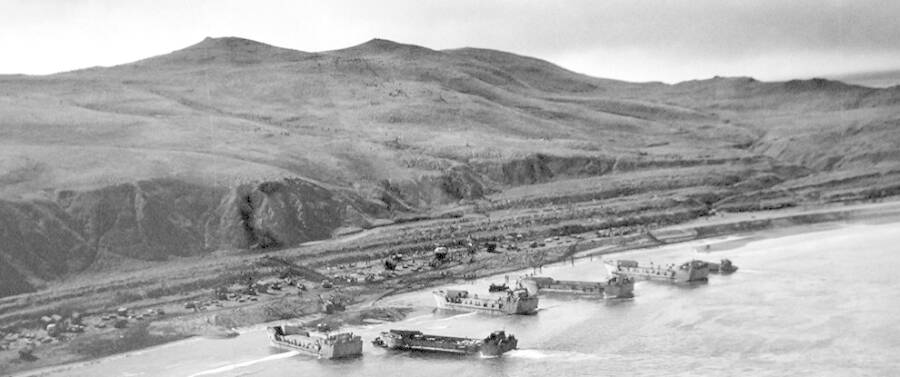
Pictured: Canadian and US forces establish the beachhead on Kiska, 16 August 1943
By the time the Americans declared Attu neutralized and clear on 30 May, they had paid a heavy price for it: 549 killed in action, 1,148 wounded, and over 1,800 sick or dead from frostbite and typhus. And they only captured 28 Japanese soldiers alive. The fields of Attu were strewn with over 2,800 Japanese dead - killed in action, or dead by seppuku (ritual suicide, either by sword or grenade), rather than shamefully surrendering.
All this awful news was not exactly welcomed by the Canadians of the 1st Special Service Force. Despite their vigorous and comprehensive training, they had no illusions about what to expect as their troopships made their way through the chill and the fog to the other objective — the island of Kiska.
The Japanese occupation of Kiska had been easy to obtain, but difficult to maintain. Initially capturing the island within hours (the only US installation there being a small ten-man weather station), the Japanese quickly set up shop, and almost immediately found themselves on the defensive — and on the defensive they would remain for the next eleven months. The Americans waged almost daily aerial harassment attacks against Kiska, operating from distant airbases on the Alaskan mainland. Roving US Navy warships intercepted, attacked, and sunk most Japanese attempts to reinforce and resupply this new northern Axis garrison. The determined Allied opposition stymied Imperial plans for island-hopping their way to the North American mainland. With the overall Pacific situation gradually turning against the Japanese, and following Attu’s reconquest, the Imperial High Command declared the Aleutian holdings to be untenable, and in a rare occurrence, discreetly ordered the withdrawal of the remaining Japanese forces.
In a daring operation that occurred right under the noses of the US Navy, on the night of 29 July a Japanese fleet of 2 light cruisers and 10 destroyers (commanded by the wily Japanese Rear-Admiral Kimura Masatomi, a veteran of both Pearl Harbor and Midway) wove snakelike through the smaller islands of the western Aleutian chain through the cover of darkness and the ever-present fog. Every man in the entire Japanese garrison (almost 5,200 strong) was spirited off of Kiska. The rescue fleet escaped unnoticed and safely sailed home to Japan, with the Allies none the wiser.
The Canadians and the Americans of the 1st Special Service Force knew nothing of this. All they knew was the horror story of Attu, and that their troopships were approaching the barren shores of Kiska for the second chapter.
In the predawn hours of 15 August 1943, the Devil’s Brigade found themselves surprised to have joined a vast Allied armada of over a hundred US Navy warships clustered in the waters off Kiska Island. A massive preliminary naval bombardment softened up the Japanese coastal emplacements, and by the end of the day the 1SSF was part of a 34,000-man invasion force (codenamed “Operation Cottage”) whose landing craft and troop barges crunched onto the rocky shore.
Besides the 1SSF, other Allied units gathered for Operation Cottage included the 6th Canadian Infantry Division, the US 87th Mountain Regiment, and the US 7th Infantry Division - the Allies meant business. The Allied High Command assumed the fight for Kiska would be a bloody repeat of Attu, and had beefed up the formations accordingly — despite ongoing aerial-reconnaissance reports that pointed to the enemy positions being abandoned weeks before.
The Allies charged onto the sand and the snow to do battle and, to their astonishment, encountered no enemy resistance whatsoever. The beachhead rapidly consolidated itself, but the overall tension among the troops remained; the Japanese had done the same thing, from Guadalcanal onward: allow the Allies to get ashore unmolested, lull them into a false sense of security, and when they moved deeper inland — attack them hard and drive them back into the sea.
For the next two days, the combined American and Canadian units stumbled their way on foot through the boot-sucking moss and tundra of Kiska. Spoken orders were lost in the howling winds. Nothing could be seen farther than fifty feet through the ghostly fog. No summer warmth to be found in this subarctic August. The 1SSF came across one abandoned Japanese stronghold after another, finding no trace of the elusive enemy — command bunkers, machine-gun nests, sandbagged trenches, airstrips, submarine pens, all stripped and empty.
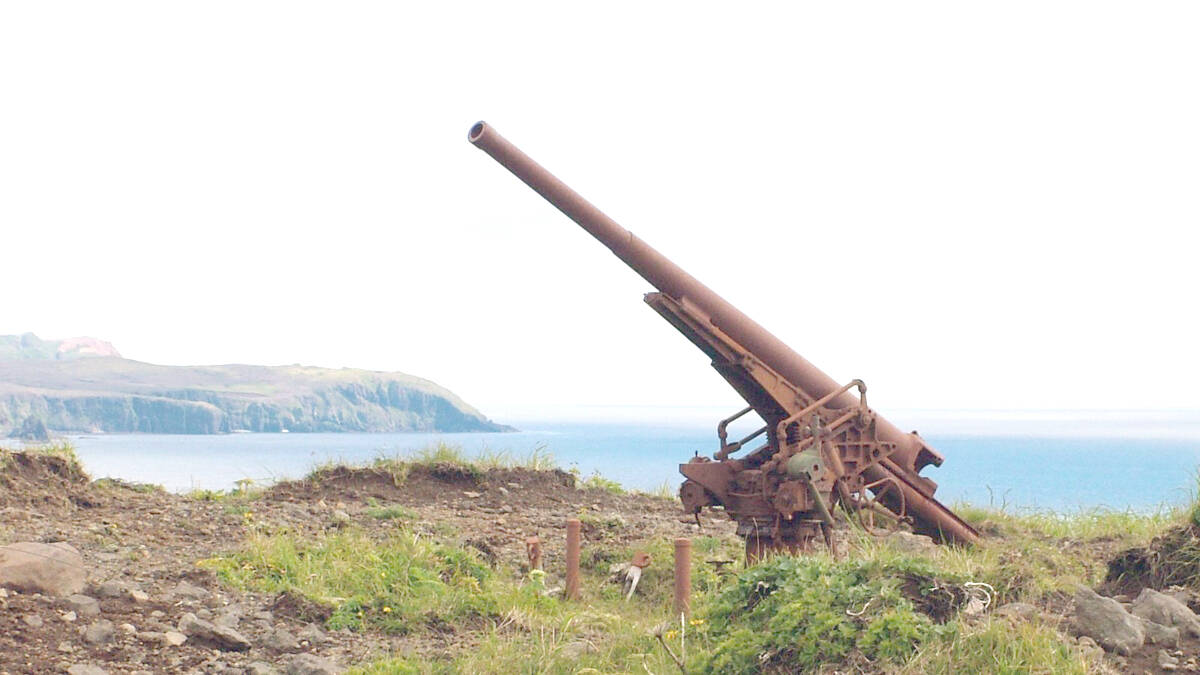
Pictured: Abandoned Japanese artillery on Kiska as it appears today
The commonsense truth of the situation rippled through the line troops: the Japanese weren’t there. The frustrated Allied commanders, from commanding Admiral Thomas Kincaid on down, were all still smarting from bloody Attu, and they would have none of it: it was glaringly obvious the Japanese had simply retreated deeper into the forbidding snow-clawed mountains of Kiska, and by God they were to be sought out and flushed out.
With commanders’ vanity pushing the confusion further, there sadly came one of the most tragic incidents of so-called “friendly fire” the Western Allies suffered in all of World War II: a Canadian platoon and an American platoon stumbled into each other in the fog, mistook each other for the Japanese, and opened fire on each other; by the time the shooting stopped, 28 Americans and four Canadians were killed, with 50 wounded on both sides. That, along with leftover Japanese landmines, assorted booby-traps, vehicular accidents, and accidental explosions, caused 224 Allied dead and 368 wounded before Admiral Kincaid finally admitted that the Japanese were indeed long gone, and called the bewildering fiasco of Operation Cottage to an ignominious halt.
There were still many valuable lessons to be learned overall from the Aleutians. The US forces in the South Pacific were ramping up their island-hopping campaign in the Solomon Islands and New Guinea, and the new tactics of complex amphibious warfare were sharpened up from analysis of the Attu and Kiska operations.
The 1st Special Services Force rapidly recovered their mettle and morale in the aftermath of Kiska, and in November 1943 was transferred to the Italian Theatre of War, joining the US 36th Infantry Division along the Gustav Line. Despite suffering heavy casualties, the 1SSF were respected as worthy foes by the tough German paratrooper divisions they faced. The 1SSF was now well-thought-of by Allied commanders, who considered them an ideal “fire-team” to break combat stalemates anywhere the Allies needed to tip the scales of combat.
The unit was next transferred to Anzio, where their shock-troop tactics were key in shattering the German defenses and allowing the Allied units besieged in the bridgehead to break out into open country.
In August 1944 the 1SSF took part in Operation Dragoon (the invasion of Nazi-occupied Southern France along the Mediterranean coast), and fought with valor and distinction as they cleared stubborn German units from the French provinces bordering Italy.
Following the final defeat of the final German stragglers in France in December 1944, the 1st Special Services Force was officially disbanded by the Allied High Command. The surviving 1SSF members were assigned to various other existing elite American and Canadian units to continue the war in Europe on to V-E Day, and although little-known today, the Force is still highly regarded in Western military circles.
And so it stands that World War II for Canada was not all just a remote series of distant events safely unfolding beyond the safety of two oceans. World War II was not merely four-column banner-headlines read in the morning papers, or doomy news reports delivered over CBC Radio by the sonorous voice of Lorne Greene. World War II also happened in Canada’s backyard.
• • •
The Alaska Highway
The Alaska Highway is one of the more remarkable feats of combined civil and military engineering undertaken anywhere in North America during the 20th Century.
Weeks after the US declared war on Japan, the US Army Corps of Engineers joined with the Canadian Government to rapidly construct a viable route for resupply and reinforcements in case the Axis Powers did attempt to occupy Alaska or the coastal regions of British Columbia. A finalized route 2,232km long was decided upon, beginning at Dawson Creek BC, twisting its way northwestward through Fort Nelson and Whitehorse to finally terminate at Delta Junction in Alaska.
Work commenced on 9 March 1942, with over 10,000 troops of the US Army Construction Battalions (nicknamed “Seabees” for their CB abbreviation) working towards each other from either terminus of the Alaska Highway in two separate groups — through stretches of pine forest, towering mountain passes, whitewater rivers, and swarms of giant mosquitoes.
The Seabees worked around the clock, seven days a week, punching in a mud-slopped vehicle path barely two lanes wide through a vast wilderness. A long trail of discarded oil drums, fuel cans, worn-out construction equipment, and battered vehicles beyond repair was left in the Seabees’ wake. News of the Japanese attack on the Aleutians spurred the Seabees to even greater agonizing efforts, and finally in September the two workforces met, grimy and weary, at the BC/Yukon border.
The Alaska Highway was officially declared open on 28 October 1942, but that over-optimistic government announcement was more for morale-boosting publicity than anything else. The resultant roadway was little more than a long, tangled mess of steep grades, precarious switchbacks, poor road surfaces pontoon bridges, wooden bridges of varying sizes and strengths, and terrifying drops into deep gorges, unprotected by any guard-rail systems. Problems with thawing permafrost and torrential rains also caused much havoc all along the length of the highway, and the Seabees were repeatedly frustrated, mired down in endless and thankless repair work.
It wasn’t until late 1943 that the roadway was finally declared suitable for heavy military transport operations. However (as we will see), the Japanese invasion threat had subsided by then — and now, with the pressure off, more care was invested in bettering the route. Ironically, it wasn’t until the years immediately following World War II that the Alaska Highway as we know it was widened and improved (and even paved!) - which boosted not only Canadian population, industry, commerce, and tourism across Northern BC and the Yukon, but also sped up Alaska’s inclusion into the US as an Official State in 1959.
